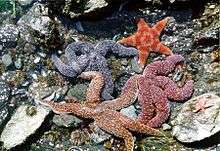Ambulacraria
| Ambulacrarians Temporal range: Early Cambrian - Recent | |
|---|---|
 | |
| Various sea stars and sea urchins among mussel shells in the rocky intertidal zone of Kachemak Bay. | |
| Scientific classification | |
| Kingdom: | Animalia |
| Subkingdom: | Eumetazoa |
| (unranked): | Bilateria |
| Superphylum: | Deuterostomia |
| (unranked): | Ambulacraria |
| Phyla | |
| |
Ambulacraria or Coelomopora is a Superphylum of invertebrate phyla which includes echinoderms and hemichordates;[1] a member of this group is called an ambulacrarian. Phylogenetic analysis suggest the echinoderms and hemichordates separated around 533 million years ago.[2] The Ambulacraria are part of the deuterostomes, a larger clade that also includes the Chordata, Vetulicolia and Saccorhytus.
The two living clades with representative organisms are:
- Echinodermata (sea stars, sea urchins, brittle stars, sea cucumbers, feather stars, sea lilies, etc.)
- Hemichordata (acorn worms, Pterobranchia, and possibly graptolites)
The group Xenoturbellida (two species of worm-like animals) has previously been considered to be in this clade, but is now considered to be placed more basally among Metazoans.[3]
Fossil taxa that may lie on the stem lineage:
- Superphylum Ambulacraria
- unranked clade Cambroernida
- † unranked clade = Eldoniida
- † Stellostomites Caron, Conway Morris & Shu, 2010[4]
- † Velumbrella?
- † Herpetogaster Caron, Conway Morris & Shu, 2010[4] - with one species: † Herpetogaster collinsi Caron, Conway Morris & Shu, 2010[4]
- † Rotadisciidae
- † unranked clade = Eldoniida
- unranked clade Cambroernida
References
- ↑ Cannon, Johanna Taylor; Vellutini, Bruno Cossermelli; Smith, Julian; Ronquist, Fredrik; Jondelius, Ulf; Hejnol, Andreas. "Xenacoelomorpha is the sister group to Nephrozoa". Nature. 530 (7588): 89–93. doi:10.1038/nature16520.
- ↑ Sea Cucumber Genome Imparts Insight on Genes Linked to Organ Regeneration
- ↑ Edgecombe, Gregory D.; Giribet, Gonzalo; Dunn, Casey W.; Hejnol, Andreas; Kristensen, Reinhardt M.; Neves, Ricardo C.; Rouse, Greg W.; Worsaae, Katrine; Sørensen, Martin V. (June 2011). "Higher-level metazoan relationships: recent progress and remaining questions". Organisms, Diversity & Evolution. 11 (2): 151–172. doi:10.1007/s13127-011-0044-4.
- 1 2 3 Caron, J.; Conway Morris, S.; Shu, D. (2010). "Tentaculate fossils from the Cambrian of Canada (British Columbia) and China (Yunnan) interpreted as primitive deuterostomes". PLoS ONE. 5 (3): e9586. doi:10.1371/journal.pone.0009586. PMC 2833208. PMID 20221405.
- ↑ Murray, J.; MacGabhann, B. A. (2010). "Non-mineralised discoidal fossils from the Ordovician Bardahessiagh Formation, Co. Tyrone, Ireland". Irish Journal of Earth Sciences. 28: 1–12. doi:10.3318/IJES.2010.28.1.
This article is issued from
Wikipedia.
The text is licensed under Creative Commons - Attribution - Sharealike.
Additional terms may apply for the media files.